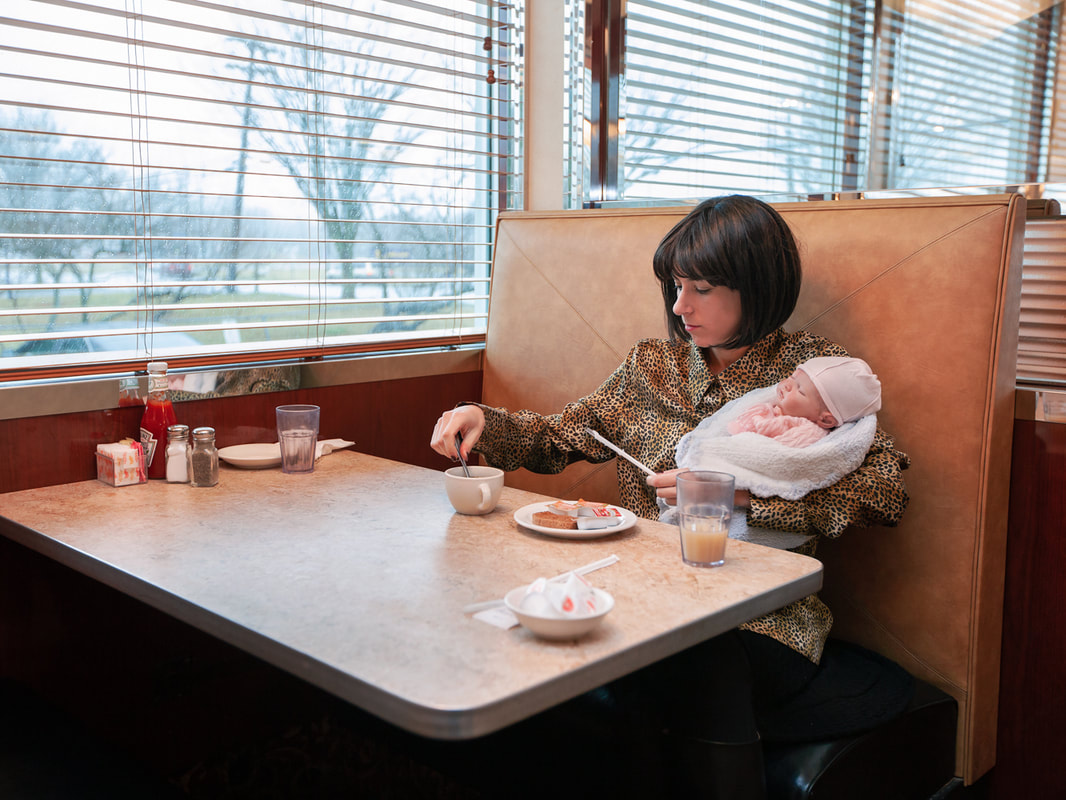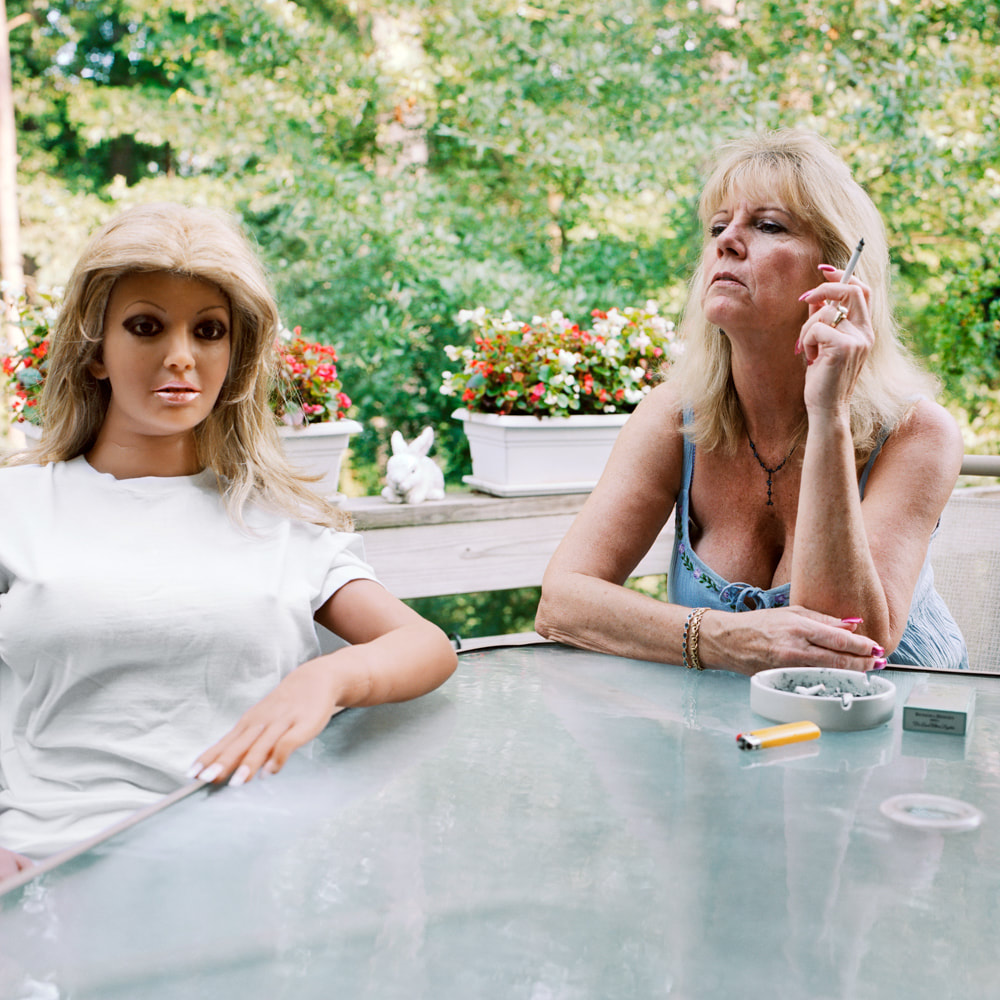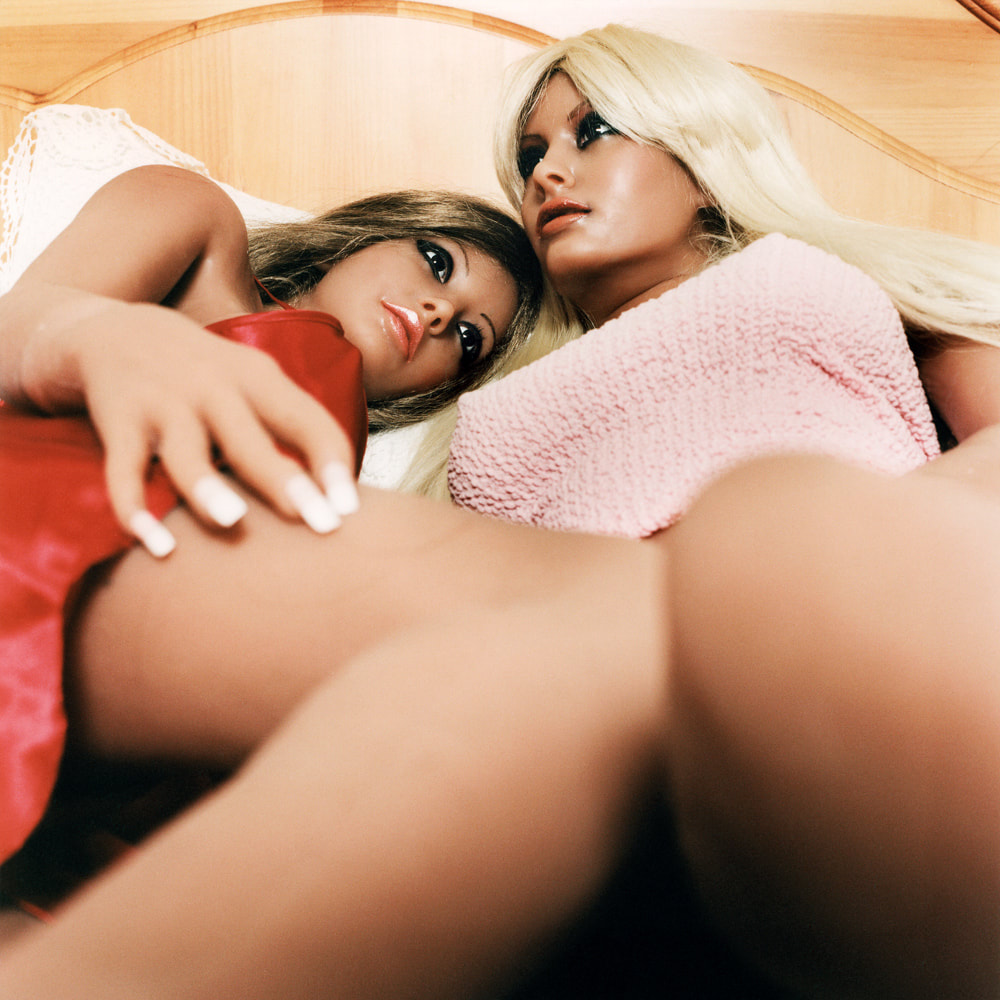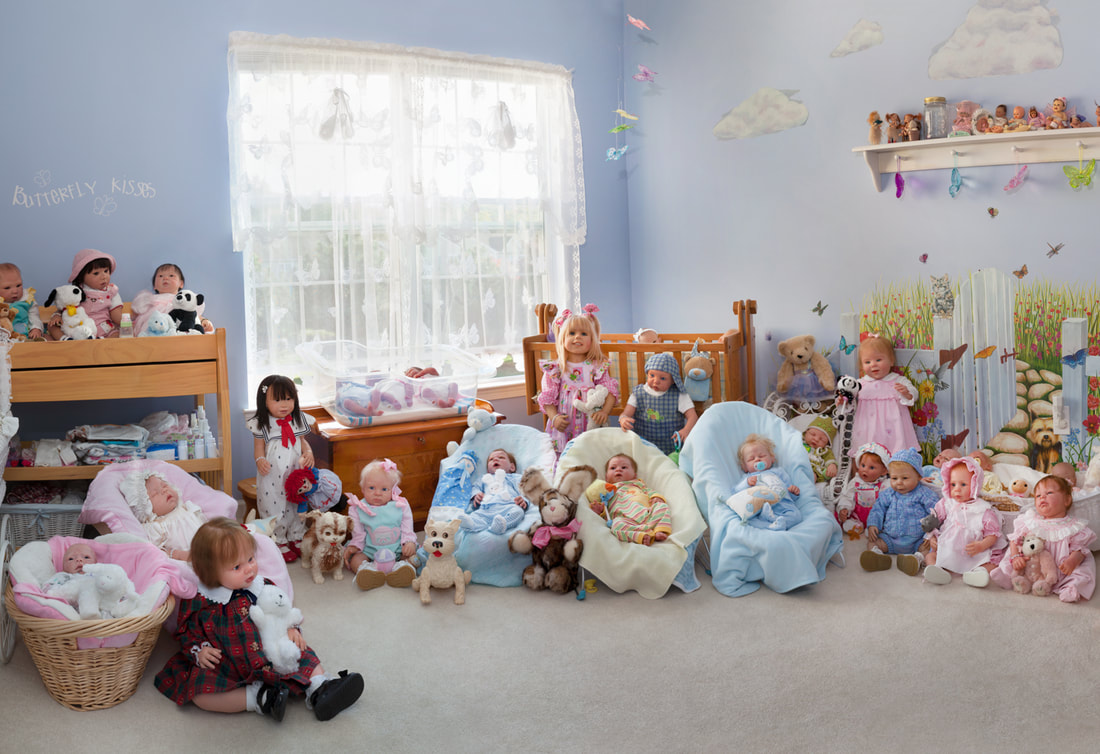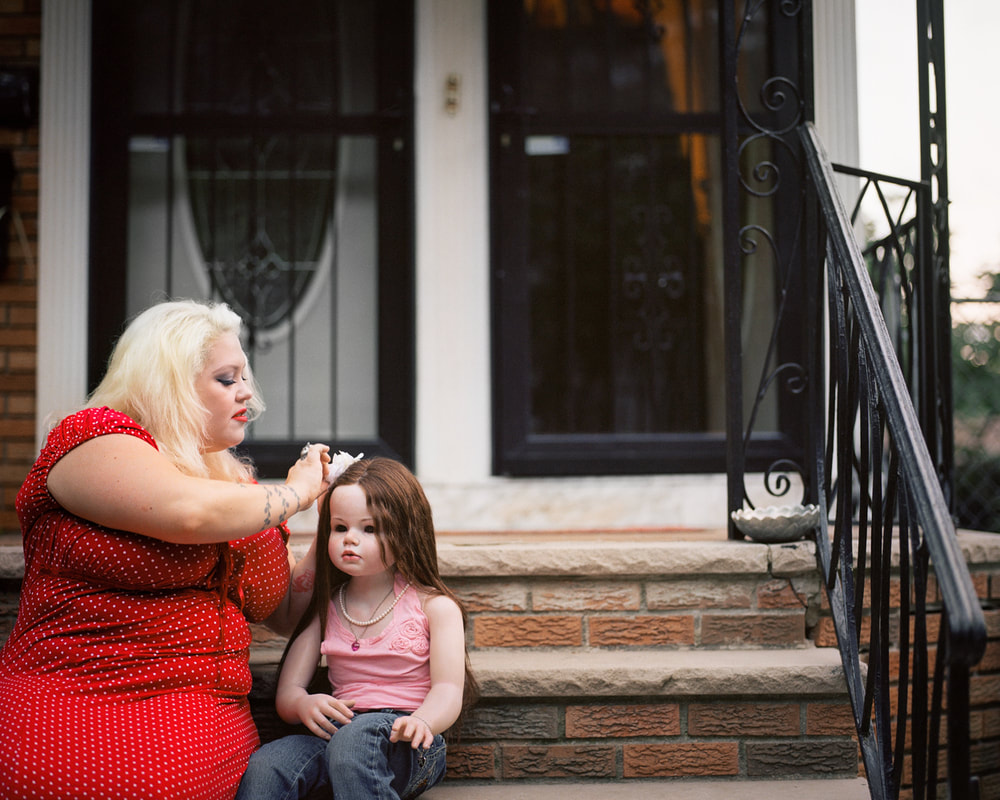Text excerpted from Quaderno, Fondazione Prada #23, the publication accompanying the exhibition Surrogati: Un Amore Ideale (Surrogate: A Love Ideal)
at Fondazione Prada’s Osservatorio gallery, Milan, Italy 2019.
at Fondazione Prada’s Osservatorio gallery, Milan, Italy 2019.
That the distinction between real and imagined, organic and synthetic may be somehow relative, not definitive, is a provocation in itself. Freud explored the “uncanny” feeling that may overwhelm us when uncertain about whether or not something is alive. The queasiness elicited by that not knowing—especially when non-living objects appear to us as somehow animate.
At first glance, photographers Jamie Diamond and Elena Dorfman seem to have focused on enduring subjects for artists: family, love, loss, friendship, and sexuality. In the case of Dorfman, her focus within those broad parameters is sexual desire and romantic love—the ideal partner; for Diamond, the subject is mother love, as idealized in Madonna-and-child iconography throughout the history of art. However, for Dorfman and Diamond--the essence of the loved one is often anything but typical.
Family images convey a spectrum of emotions, circumstances, and contexts, whether the tie that binds those depicted reflects a choice (a spouse, a lover, a friend, an adopted child) or is a matter of blood (a parent, sibling, or biological child). But what if that “bond” is a projected one--between a human and an idealized surrogate for a human? That question is at the heart of Jamie Diamond’s and Elena Dorfman’s documentation of intimacy with inanimate humanoids.
At first glance, photographers Jamie Diamond and Elena Dorfman seem to have focused on enduring subjects for artists: family, love, loss, friendship, and sexuality. In the case of Dorfman, her focus within those broad parameters is sexual desire and romantic love—the ideal partner; for Diamond, the subject is mother love, as idealized in Madonna-and-child iconography throughout the history of art. However, for Dorfman and Diamond--the essence of the loved one is often anything but typical.
Family images convey a spectrum of emotions, circumstances, and contexts, whether the tie that binds those depicted reflects a choice (a spouse, a lover, a friend, an adopted child) or is a matter of blood (a parent, sibling, or biological child). But what if that “bond” is a projected one--between a human and an idealized surrogate for a human? That question is at the heart of Jamie Diamond’s and Elena Dorfman’s documentation of intimacy with inanimate humanoids.
Dolls as protagonist or prop have populated photography since the first half of the twentieth century—for example, in the eerie work of Morton Bartlett, Hans Bellmer, Ralph Eugene Meatyard, and Frederick Sommer. More recently, Inez & Vinoodh, Laurie Simmons, Paolo Ventura, and Liu Xia, among others, have variously incorporated dolls, in some form, in their diverse work. But dolls have rarely been observed and documented as constituents in what otherwise would appear as traditional human relationships. As such, Dorfman’s and Diamond’s family pictures, their bearing witness to the conventions of their subjects’ daily lives, serve as a type of validation of those very lives.
Diamond’s “Forever Mothers” project looks at women who—because of their infertility or disinclination to bear babies, or a loss, or as a comfort in the absence of their own, now-grown children—form profound emotional bonds with lifelike silicone or vinyl “reborn” doll-babies. The “reborners”—predominately women (themselves usually collectors, as well)--craft often made-to-order, at times anatomically correct, warm and appropriately weighted baby dolls for “adoption” by these future “forever” moms. In another project, “I promise to be a good mother,” Diamond casts herself as a “perfect mother,” conforming to every stereotype the term may imply, with her own “reborn” doll baby.
Dorfman’s “Still Lovers” series takes us into the world of sex dolls—or, as she puts it, “men having sex with 125 pounds of perfectly formed synthetic female.” These men (and some women) project their sexual and romantic lust and longing—and true love, perhaps—onto customized, life-size, anatomically correct and fully penetrable female dolls that presumably fulfill any number of fantasies.
In both photographers’ projects, these lifelike surrogates inhabit the images as desired, fetishized, and idealized beings, “living” as such with their flesh and blood mothers or partners, and sometimes with their immediate families as well. Diamond shows us doting mothers in conventional home scenarios that occasionally include human “siblings.” Similarly, the “still lovers” in Dorfman’s project are, at times, part of a larger family unit that involves both husband and “organic” wife, as well as children.
Together, Diamond’s and Dorfman’s work presented in Surrogate: A Love Ideal vividly and nonjudgmentally documents the interactions of humans with their lifelike, inanimate companions. We are not always sure what we are looking at, an interesting twist in this most—at least historically— evidentiary of mediums. Entering the “uncanny valley” of their work, we question the essential and elemental nature not only of what we are seeing—“can we believe our eyes?”—but also of love, intimacy, and life itself.
Diamond’s “Forever Mothers” project looks at women who—because of their infertility or disinclination to bear babies, or a loss, or as a comfort in the absence of their own, now-grown children—form profound emotional bonds with lifelike silicone or vinyl “reborn” doll-babies. The “reborners”—predominately women (themselves usually collectors, as well)--craft often made-to-order, at times anatomically correct, warm and appropriately weighted baby dolls for “adoption” by these future “forever” moms. In another project, “I promise to be a good mother,” Diamond casts herself as a “perfect mother,” conforming to every stereotype the term may imply, with her own “reborn” doll baby.
Dorfman’s “Still Lovers” series takes us into the world of sex dolls—or, as she puts it, “men having sex with 125 pounds of perfectly formed synthetic female.” These men (and some women) project their sexual and romantic lust and longing—and true love, perhaps—onto customized, life-size, anatomically correct and fully penetrable female dolls that presumably fulfill any number of fantasies.
In both photographers’ projects, these lifelike surrogates inhabit the images as desired, fetishized, and idealized beings, “living” as such with their flesh and blood mothers or partners, and sometimes with their immediate families as well. Diamond shows us doting mothers in conventional home scenarios that occasionally include human “siblings.” Similarly, the “still lovers” in Dorfman’s project are, at times, part of a larger family unit that involves both husband and “organic” wife, as well as children.
Together, Diamond’s and Dorfman’s work presented in Surrogate: A Love Ideal vividly and nonjudgmentally documents the interactions of humans with their lifelike, inanimate companions. We are not always sure what we are looking at, an interesting twist in this most—at least historically— evidentiary of mediums. Entering the “uncanny valley” of their work, we question the essential and elemental nature not only of what we are seeing—“can we believe our eyes?”—but also of love, intimacy, and life itself.
I asked Jamie and Elena to speak with me together about their work and experiences, and where their projects may share some characteristics. What follows is an excerpt of that conversation:
Melissa Harris: There seems to be a certain amount of common ground shared by your two projects, synergy between their emotional and psychological underpinnings. Many of your subjects I spoke with made an analogy to having a pet. We use that word ‘anthropomorphize’—the way people converse with or refer to animals and their emotional lives as if they are human, but even in these instances, they’re still interacting with a living creature. How does all this happen with synthetic creatures? How do we bestow human qualities, a type of life itself, on the inorganic? Everyone I spoke with made it completely clear to me that they are not delusional–they know they are interacting with dolls. It just did not matter to them, and that's in part what is so provocative. Where does that reality, or lack of reality, or fantasy or… Where are the lines here, the moments of transition…?
Elena Dorfman: In the case of the sex dolls, they are so lifelike that they fall into the uncanny valley. My experience was that in order to live with a silicone surrogate over an extended period of time, to devote so much of your life, energy, and finances to her (these dolls are expensive), she has to be given a life story, which nearly every man conjured.
Jamie Diamond: It's the same for my subjects on so many levels. What's interesting to me is while making the dolls, I knew I was done when I had that visceral response… when I felt the urge to hold it. Something gets triggered. It's hard to articulate because it's just something that you feel so deeply within yourself, that it feels real.
Dorfman: In a strange way, the dolls come to life with a constructed soul and backstory.
Melissa Harris: There seems to be a certain amount of common ground shared by your two projects, synergy between their emotional and psychological underpinnings. Many of your subjects I spoke with made an analogy to having a pet. We use that word ‘anthropomorphize’—the way people converse with or refer to animals and their emotional lives as if they are human, but even in these instances, they’re still interacting with a living creature. How does all this happen with synthetic creatures? How do we bestow human qualities, a type of life itself, on the inorganic? Everyone I spoke with made it completely clear to me that they are not delusional–they know they are interacting with dolls. It just did not matter to them, and that's in part what is so provocative. Where does that reality, or lack of reality, or fantasy or… Where are the lines here, the moments of transition…?
Elena Dorfman: In the case of the sex dolls, they are so lifelike that they fall into the uncanny valley. My experience was that in order to live with a silicone surrogate over an extended period of time, to devote so much of your life, energy, and finances to her (these dolls are expensive), she has to be given a life story, which nearly every man conjured.
Jamie Diamond: It's the same for my subjects on so many levels. What's interesting to me is while making the dolls, I knew I was done when I had that visceral response… when I felt the urge to hold it. Something gets triggered. It's hard to articulate because it's just something that you feel so deeply within yourself, that it feels real.
Dorfman: In a strange way, the dolls come to life with a constructed soul and backstory.
Harris: It speaks to the power of the human capacity for fantasy-- to be able to view an inanimate object as somehow living, with an essence, and an imagined backstory. It speaks to love, to need, to desire...
Dorfman: But this fantasy is also a reflection of technology and artistry. The dolls look so realistic it makes it easier for them to “pass” as real women. This wasn’t so true when I began nearly twenty years ago. The world we live in today, where the norms of beauty are shifting and the demand that women stay eternally youthful becomes increasingly urgent…--this, combined with medical and technological advances, and more sophisticated techniques applied to the creation of plastic women, blur the line between flesh and silicone even more.
Harris: Are you saying that flesh and blood women and dolls are brushing up against one another in a more fungible, less clearly articulated way…?
Dorfman: Yes. I did not begin “Still Lovers” with the intention of taking a feminist stance. I was an observer and chronicler. However, with the passing of time, I can’t help but notice the dollification of flesh and blood women.... We are moving toward a particular ideal, where dolls look more like women and women look more like dolls.
Dorfman: But this fantasy is also a reflection of technology and artistry. The dolls look so realistic it makes it easier for them to “pass” as real women. This wasn’t so true when I began nearly twenty years ago. The world we live in today, where the norms of beauty are shifting and the demand that women stay eternally youthful becomes increasingly urgent…--this, combined with medical and technological advances, and more sophisticated techniques applied to the creation of plastic women, blur the line between flesh and silicone even more.
Harris: Are you saying that flesh and blood women and dolls are brushing up against one another in a more fungible, less clearly articulated way…?
Dorfman: Yes. I did not begin “Still Lovers” with the intention of taking a feminist stance. I was an observer and chronicler. However, with the passing of time, I can’t help but notice the dollification of flesh and blood women.... We are moving toward a particular ideal, where dolls look more like women and women look more like dolls.
|
Harris: What’s interesting to me about both of your projects is that they challenge so many preconceptions about sex and love and relationships, family and motherhood…. They are remarkably open-ended emotionally and psychologically.
Dorfman: For the most part, the doll owners I worked with had a certain level of emotional depth, self-awareness, and self-knowledge. I was often surprised and constantly rubbing up against my own ideas of what constitutes love--and what kind of person lives with a love doll as his or her domestic partner. My preconceptions were regularly shattered. Harris: Do you consider these projects documentary in nature? Dorfman: Yes. For this series, I documented the domestic lives of men and women who live with life-sized, anatomically correct, sex dolls. Diamond: My work has always been rooted in fiction while examining the disparity between image and reality. I use photography and staged intimacy as a vehicle to question existing values regarding inherited social and gender expectations. “Forever Mothers” is interesting for me in that there is a level of reality that never existed before in my work. Everything prior to this was very much a construction that I was producing for the camera. |
Harris: Have you Photoshopped or otherwise manipulated the work we are discussing?
Dorfman: Only a small amount of postproduction—color correction, cleaning up stray hairs, that sort of thing. Nothing has been manipulated or altered in any way. What the image depicts replicates exactly the scene that was before me, except in the case of the staged doll grids.
Diamond: I finesse color, contrast and exposure at times to enhance the image, but don’t composite or manipulate the image-- everything is straight. Except for the image of the nursery, since that was three images merged into one for clarity and resolution purposes.
Dorfman: Only a small amount of postproduction—color correction, cleaning up stray hairs, that sort of thing. Nothing has been manipulated or altered in any way. What the image depicts replicates exactly the scene that was before me, except in the case of the staged doll grids.
Diamond: I finesse color, contrast and exposure at times to enhance the image, but don’t composite or manipulate the image-- everything is straight. Except for the image of the nursery, since that was three images merged into one for clarity and resolution purposes.
Harris: In some ways, it seems like Elena’s work engages a Stepford wife-ish fantasy. That is, an ideal of the perfect wife, mother, and lover concocted by the man. Is there anything analogous in your work, Jamie?
Diamond: Well, it’s different of course, but I think the fantasy for my subjects is that they can essentially perform as mothers without the need to physically go through labor, and without the real financial concerns that mothers and families face. And for many of these women, it’s not about having little boys and little girls—it’s about newborns and babies. It opens an interesting question regarding AI (Artificial Intelligence), and the idea that if we can create some sort of surrogate to love us in the way we want it to, what then are our obligations to that surrogate in return, if any?
Diamond: Well, it’s different of course, but I think the fantasy for my subjects is that they can essentially perform as mothers without the need to physically go through labor, and without the real financial concerns that mothers and families face. And for many of these women, it’s not about having little boys and little girls—it’s about newborns and babies. It opens an interesting question regarding AI (Artificial Intelligence), and the idea that if we can create some sort of surrogate to love us in the way we want it to, what then are our obligations to that surrogate in return, if any?
Harris: It seems, then, with your projects, we have to also ask what defines human, what defines life, what defines love? And then, if the being does not age, what are the implications of that? Although Jamie, from what your subjects say, the whole raison d’être of a “reborn” doll is to forever hold onto that newborn, or baby stage for precisely its own qualities, rather than as a springboard to the individual who evolves. And Elena, aging does seem to occur with the sex dolls, but their parts are infinitely replaceable, and often improving…? Does aging play more of a role when there is a flesh and blood woman in the picture, so to speak?
Dorfman: One of my photographs portrays a man who was soon to be married, but he also had a doll. He said, “my fiancé isn't upset that I have a doll, but she's upset that my doll will never grow old.”
Diamond: Regarding our projects, there are parallel narratives here that are intriguing, each involving genuine human emotion, but within a shifting set of parameters, as the dolls become more and more lifelike, and what they represent shifts.
Dorfman: At first glance, it may be easy for viewers to characterize our subjects as peculiar, or in some way deviant. But, while their chosen lifestyles or hobbies might be out of the ordinary, they pose myriad and fascinating questions about the intersection of fantasy and reality, and shed light on the human condition now--and in the future.
Dorfman: One of my photographs portrays a man who was soon to be married, but he also had a doll. He said, “my fiancé isn't upset that I have a doll, but she's upset that my doll will never grow old.”
Diamond: Regarding our projects, there are parallel narratives here that are intriguing, each involving genuine human emotion, but within a shifting set of parameters, as the dolls become more and more lifelike, and what they represent shifts.
Dorfman: At first glance, it may be easy for viewers to characterize our subjects as peculiar, or in some way deviant. But, while their chosen lifestyles or hobbies might be out of the ordinary, they pose myriad and fascinating questions about the intersection of fantasy and reality, and shed light on the human condition now--and in the future.
|
|
|


